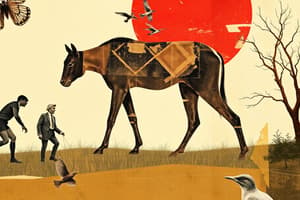Podcast
Questions and Answers
Flashcards
Typological thinking
Typological thinking
Classifying species into rigid groups with little variation. It helped with early species classification.
Scala Naturae
Scala Naturae
Aristotle's system of ranking animals and plants based on size and complexity.
Uniformitarianism
Uniformitarianism
The idea that geological processes happening now are the same as those in Earth's past.
Fossils
Fossils
Signup and view all the flashcards
Jean Baptiste Lamarck
Jean Baptiste Lamarck
Signup and view all the flashcards
Charles Lyell
Charles Lyell
Signup and view all the flashcards
Darwin's Voyage
Darwin's Voyage
Signup and view all the flashcards
Origin of Species
Origin of Species
Signup and view all the flashcards
Wallace
Wallace
Signup and view all the flashcards
Comte De Buffon
Comte De Buffon
Signup and view all the flashcards
Adaptation
Adaptation
Signup and view all the flashcards
Fitness
Fitness
Signup and view all the flashcards
Variation
Variation
Signup and view all the flashcards
Conditions for Evolution by Natural Selection
Conditions for Evolution by Natural Selection
Signup and view all the flashcards
Wallace's Line
Wallace's Line
Signup and view all the flashcards
Directional Selection
Directional Selection
Signup and view all the flashcards
Stabilizing Selection
Stabilizing Selection
Signup and view all the flashcards
Disruptive Selection
Disruptive Selection
Signup and view all the flashcards
Example of Directional Selection
Example of Directional Selection
Signup and view all the flashcards
Example of Stabilizing Selection
Example of Stabilizing Selection
Signup and view all the flashcards
Example of Disruptive Selection
Example of Disruptive Selection
Signup and view all the flashcards
Convergent Evolution
Convergent Evolution
Signup and view all the flashcards
Genetic Drift
Genetic Drift
Signup and view all the flashcards
Founder Effect
Founder Effect
Signup and view all the flashcards
Population Bottlenecks
Population Bottlenecks
Signup and view all the flashcards
Genetic Drift is Most Potent When
Genetic Drift is Most Potent When
Signup and view all the flashcards
Gene Flow
Gene Flow
Signup and view all the flashcards
Importance of Gene Flow
Importance of Gene Flow
Signup and view all the flashcards
Mutation
Mutation
Signup and view all the flashcards
Inbreeding Depression
Inbreeding Depression
Signup and view all the flashcards
Hardy-Weinberg Equilibrium
Hardy-Weinberg Equilibrium
Signup and view all the flashcards
Hardy-Weinberg Equations
Hardy-Weinberg Equations
Signup and view all the flashcards
Conditions for Hardy-Weinberg Equilibrium
Conditions for Hardy-Weinberg Equilibrium
Signup and view all the flashcards
Random Mating
Random Mating
Signup and view all the flashcards
Sexual Selection
Sexual Selection
Signup and view all the flashcards
Sexual Dimorphism
Sexual Dimorphism
Signup and view all the flashcards
Secondary Sexual Trait
Secondary Sexual Trait
Signup and view all the flashcards
Parental Investment
Parental Investment
Signup and view all the flashcards
Female Investment
Female Investment
Signup and view all the flashcards
Male Investment
Male Investment
Signup and view all the flashcards
Variation in Reproductive Success
Variation in Reproductive Success
Signup and view all the flashcards
Variance
Variance
Signup and view all the flashcards
Direct Benefits of Mate Choice
Direct Benefits of Mate Choice
Signup and view all the flashcards
Indirect Benefits of Mate Choice
Indirect Benefits of Mate Choice
Signup and view all the flashcards
Good Genes Hypothesis
Good Genes Hypothesis
Signup and view all the flashcards
Runaway Selection Hypothesis
Runaway Selection Hypothesis
Signup and view all the flashcards
Species
Species
Signup and view all the flashcards
Biological Species Concept
Biological Species Concept
Signup and view all the flashcards
Morphospecies Concept
Morphospecies Concept
Signup and view all the flashcards
Phylogenetic Species Concept
Phylogenetic Species Concept
Signup and view all the flashcards
Cryptic Species
Cryptic Species
Signup and view all the flashcards
Prezygotic Isolation
Prezygotic Isolation
Signup and view all the flashcards
Temporal Isolation
Temporal Isolation
Signup and view all the flashcards
Habitat Isolation
Habitat Isolation
Signup and view all the flashcards
Behavioral Isolation
Behavioral Isolation
Signup and view all the flashcards
Gametic Isolation
Gametic Isolation
Signup and view all the flashcards
Mechanistic Isolation
Mechanistic Isolation
Signup and view all the flashcards
Postzygotic Isolation
Postzygotic Isolation
Signup and view all the flashcards
Hybrid Inviability
Hybrid Inviability
Signup and view all the flashcards
Hybrid Sterility
Hybrid Sterility
Signup and view all the flashcards
Outgroup
Outgroup
Signup and view all the flashcards
Node
Node
Signup and view all the flashcards
Polytomy
Polytomy
Signup and view all the flashcards
Synapomorphy
Synapomorphy
Signup and view all the flashcards
Monophyletic Group
Monophyletic Group
Signup and view all the flashcards
Paraphyletic Group
Paraphyletic Group
Signup and view all the flashcards
Polyphyletic Group
Polyphyletic Group
Signup and view all the flashcards
Homology
Homology
Signup and view all the flashcards
Homoplasy
Homoplasy
Signup and view all the flashcards
Speciation
Speciation
Signup and view all the flashcards
Allopatric Speciation
Allopatric Speciation
Signup and view all the flashcards
Sympatric Speciation
Sympatric Speciation
Signup and view all the flashcards
Ring Species
Ring Species
Signup and view all the flashcards
Hybrid Zones
Hybrid Zones
Signup and view all the flashcards
Adaptive Radiation
Adaptive Radiation
Signup and view all the flashcards
Parameters of Adaptive Radiation
Parameters of Adaptive Radiation
Signup and view all the flashcards
Ecological Theory of Adaptive Radiation
Ecological Theory of Adaptive Radiation
Signup and view all the flashcards
Mass Extinction
Mass Extinction
Signup and view all the flashcards
Background Extinction
Background Extinction
Signup and view all the flashcards
Cambrian Explosion
Cambrian Explosion
Signup and view all the flashcards
Permian Mass Extinction
Permian Mass Extinction
Signup and view all the flashcards
K-T Mass Extinction
K-T Mass Extinction
Signup and view all the flashcards
6th Mass Extinction
6th Mass Extinction
Signup and view all the flashcards
Animal Migrations
Animal Migrations
Signup and view all the flashcards
Baby Turtle Senses
Baby Turtle Senses
Signup and view all the flashcards
Adult Turtles Use True Navigation
Adult Turtles Use True Navigation
Signup and view all the flashcards
Polygyny
Polygyny
Signup and view all the flashcards
Polyandry
Polyandry
Signup and view all the flashcards
Promiscuity
Promiscuity
Signup and view all the flashcards
Monogamy
Monogamy
Signup and view all the flashcards
Defendability
Defendability
Signup and view all the flashcards
Population
Population
Signup and view all the flashcards
Major Characteristics of Populations
Major Characteristics of Populations
Signup and view all the flashcards
Dispersion
Dispersion
Signup and view all the flashcards
Population Demography
Population Demography
Signup and view all the flashcards
Factors Influencing Size
Factors Influencing Size
Signup and view all the flashcards
Factors Influencing Structure
Factors Influencing Structure
Signup and view all the flashcards
Age Pyramids
Age Pyramids
Signup and view all the flashcards
Life Tables
Life Tables
Signup and view all the flashcards
Study Notes
Typological Thinking
- Early species classification grouped species with minimal variance.
Scala Naturae
- Aristotle's ranking system categorized species based on size and perceived complexity.
Uniformitarianism
- Earth's geological processes are consistent and ongoing.
Fossils
- Fossil discoveries revealed extinct organisms, challenging established views of Earth's history.
Jean-Baptiste Lamarck
- Proposed evolutionary ideas but incorrectly suggested traits acquired during an organism's lifetime could be passed to offspring.
- Also proposed spontaneous generation.
Charles Lyell
- Lyell's uniformitarianism influenced Darwin's ideas on gradual change in species.
Darwin's Voyage
- Darwin observed fossils, environmental changes due to earthquakes, and variations in tortoises across different islands.
Origin of Species
- Darwin published "On the Origin of Species," detailing the theory of natural selection.
- Darwin's observations from his voyage led to the development of natural selection.
Wallace
- Wallace independently reached similar conclusions about natural selection as Darwin.
- The Wallace Line showcases different species distributions in Asia and Australia.
Comte de Buffon
- Advocated for empiricism, the use of evidence-based scientific claims.
Adaptation
- A heritable trait that increases survival and reproduction in a specific environment.
Fitness
- An individual's ability to produce viable offspring relative to others of the same species.
Variation
- Variation within a population is crucial for natural selection, as heritable variation allows populations to evolve.
Conditions for Evolution by Natural Selection
- Variation, Heritability, Differential survival and reproduction, population growth
Wallace's Line
- The Wallace Line marks a boundary in the distribution of species between Asia and Australia.
Descriptive Statistics in Life Science
- Quantitative tools for measuring differences and variations in populations.
Directional Selection
- Selection that shifts the population mean in one direction.
Stabilizing Selection
- Selection maintaining the population mean and reducing variation.
Disruptive Selection
- Selection favoring both extremes of a trait distribution
Example of Directional Selection
- Antibiotic resistance evolution.
Example of Stabilizing Selection
- Galapagos finches with intermediate beak sizes favored during drought.
Example of Disruptive Selection
- Pocket mice with light or dark fur favored over intermediate colors for camouflage.
Convergent Evolution
- The independent evolution of similar traits in unrelated species.
Genetic Drift
- Random changes in allele frequencies due to chance events, leading to loss or fixation of alleles
Founder Effect
- A small population establishes a new population and carries different allele frequencies.
Population Bottlenecks
- Sudden reduction in population size that alters allele frequencies independent of adaptation.
Genetic Drift is Most Potent When
- Populations are small, and allele frequencies are limited.
Gene Flow
- Movement of alleles between populations through migration and breeding.
Importance of Gene Flow
- Increases genetic variation within populations but reduces it between populations.
Mutation
- A random process that introduces new genetic variation.
Inbreeding Depression
- Decrease in fitness due to increased homozygosity and reduced heterozygosity.
Hardy-Weinberg Equilibrium
- Conditions where allele and genotype frequencies remain constant.
Hardy-Weinberg Equations
- p+q=1 and p^2+2pq+q^2=1
Conditions for Hardy-Weinberg Equilibrium
- Random mating, no mutations, no genetic drift, no gene flow, and no natural selection
Random Mating
- Mate selection without preference or bias.
Sexual Selection
- Traits that increase mating success but may not increase survival.
Sexual Dimorphism
- Differences in traits between males and females within a species.
Secondary Sexual Traits
- Traits specific to one sex but not directly related to reproduction.
Parental Investment
- Resource allocation by a parent to increase offspring survival
Female investment
- Greater energy invested in offspring because females produce eggs/ova.
Male investment
- Competition, displays, etc
Variation in Reproductive Success
- Differences in successful mating by males and females.
Variance
- Variance is a key component in sexual selection.
Direct Benefits of Mate Choice
- Food, protection, etc.
Indirect Benefits of Mate Choice
- Attractiveness, good genes of the mate.
Good Genes Hypothesis
- Preference for extreme traits as indicators of good health.
Runaway Selection Hypothesis
- Extreme sexual traits become prevalent due to positive feedback.
Species
- Evolutionary independent population(s).
Biological Species Concept
- Reproductive isolation as the defining feature of species.
Morphospecies Concept
- Morphological similarity as the indicator of species.
Phylogenetic Species Concept
- Species defined by cladistic monophyly (monophyletic groups).
Cryptic Species
- Two species that look alike but are reproductively isolated .
Prezygotic Isolation
- Mechanisms preventing mating between species.
Temporal Isolation
- Breeding occurring at different times.
Habitat Isolation
- Species occupying different habitats.
Behavioral Isolation
- Species with different mating rituals.
Gametic Isolation
- Incompatible egg and sperm.
Mechanistic Isolation
- Physical incompatibility preventing mating.
Postzygotic Isolation
- Reduced fitness in offspring of interspecies mating.
Hybrid Inviability
- Hybrid offspring fail to develop.
Hybrid Sterility
- Hybrid offspring cannot reproduce.
Outgroup
- Ancestral group on a phylogeny.
Node
- Points where branches split on a phylogenetic tree.
Polytomy
- Branch point with more than two lineages.
Synapomorphy
- Shared derived trait.
Monophyletic Group
- Group including ancestor and all its descendants.
Paraphyletic Group
- A group that includes the common ancestor but not all descendants.
Polyphyletic Group
- A group that does not include the common ancestor .
Homology
- Similarity due to common ancestry.
Homoplasy
- Similarity due to convergent evolution or other reasons.
Speciation
- The formation of new species.
Allopatric Speciation
- Speciation due to geographic isolation (dispersal or vicariance).
Sympatric Speciation
- Speciation within the same geographic area.
Ring Species
- Species interbreeding along a geographic ring.
Hybrid Zones
- Region where interbreeding occurs and fitness is reduced.
Adaptive Radiation
- Rapid speciation from a common ancestor.
Parameters for Adaptive Radiation
- Rapid speciation, trait-environment correlations, trait utility, and common ancestry.
Ecological Theory of Adaptive Radiation
- Phenotypic divergence, competition, ecological separation and new species.
Mass Extinction
- Widespread extinction of species.
Background Extinction
- Normal extinction rate.
Cambrian Explosion
- Rapid diversification of life 542 million years ago.
Permian Mass Extinction
- Catastrophic extinction event 250-248 million years ago.
K–Pg extinction
- Mass extinction 65 million years ago, causing dinosaur extinction.
6th Mass Extinction
- Current period of accelerated extinction.
Animal Migrations
- Periodic movement between locations.
Baby Turtle Senses
- Vision, wave orientation, and magnetic fields help them navigate.
Adult Turtle Navigation
- Adult turtles use magnetic fields for true navigation, understanding their location in relation to their goal.
Polygyny
- One male mates with multiple females, often involving habitat or group defense.
Polyandry
- One female mates with multiple males, often involving resources or defenses.
Promiscuity
- No prolonged interactions between males and females
Monogamy
- Long-term pairing between one male and one female.
Defendability
- The ability to protect mates and resources for reproduction .
Population
- Group of interbreeding or potentially interbreeding individuals.
Major Characteristics of Populations
- Geographic range, size, and spatial distribution.
Dispersion (Spatial Distribution)
- Clumped, uniform, or random.
Population Demography
- Factors influencing population size and structure.
Factors influencing Population Size
- Emigration, immigration, births, deaths.
Factors influencing Population Structure
- Age distribution, survival rates, offspring production by different age groups.
Age Pyramids
- Visual representation of age distribution in a population, useful for assessing stage of development.
Life Tables
- Summarization of survival and reproduction rates in a population.
Studying That Suits You
Use AI to generate personalized quizzes and flashcards to suit your learning preferences.




